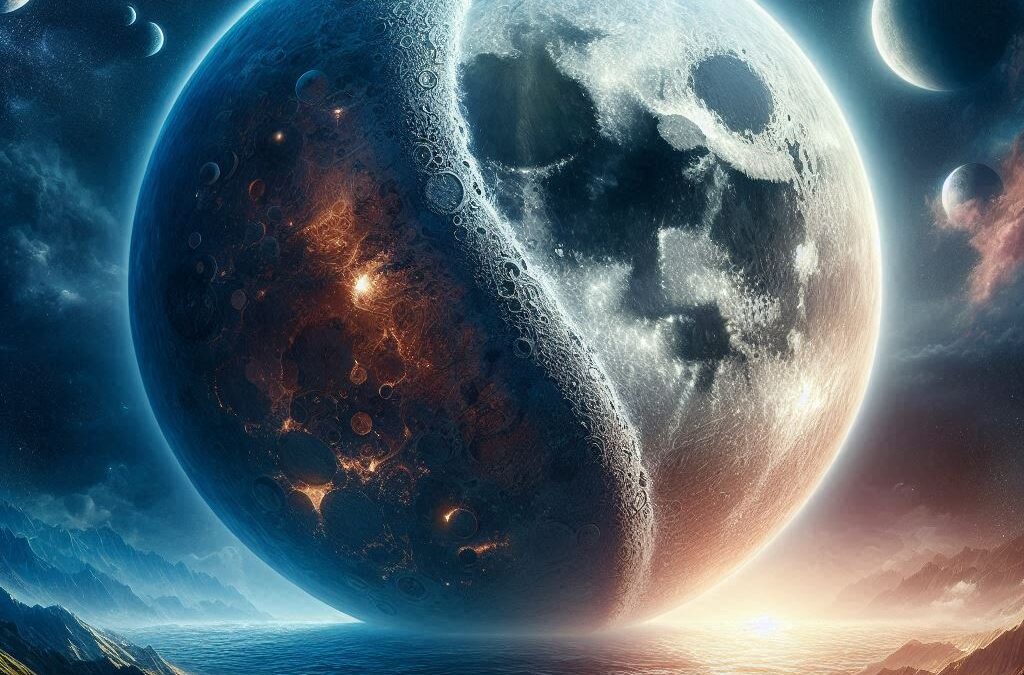In a Nutshell:
The Moon is more than just a luminous body lighting our nights—it’s a key player in Earth’s stability and history. Ancient texts speak of a time when the Moon did not exist, linking its arrival to catastrophic floods and the stabilization of Earth’s seasons. Its peculiar traits—like its “hollow” resonance, ancient rocks, and synchronized orbit—suggest there’s more to the Moon than meets the eye. Could it be that this enigmatic satellite has played an intentional role in Earth’s evolution?
Unraveling the Moon’s Puzzling History:
1. Writings of a Moonless Earth
Ancient accounts from various cultures hint at a time when Earth existed without a Moon. For instance:
- Aristotle’s student Apollonius of Rhodes and the Roman author Censorinus referenced legends from Arcadia, a region in Greece. The Arcadians were known as “Proselenes,” meaning “before the Moon,” suggesting their culture predated the Moon’s appearance.
- Zulu folklore in Africa tells of a time when “the Earth was once covered in a watery mist” before the Moon arrived, bringing balance to Earth’s chaos.
These accounts often associate the Moon’s emergence with great floods, which aligns with geological evidence of sudden, massive inundations during prehistoric times.
2. The Moon and Earth’s Stability
The Moon’s gravitational pull stabilizes Earth’s axial tilt, which is crucial for maintaining consistent seasons. Before the Moon’s presence, Earth’s axis likely wobbled chaotically, causing extreme climate shifts. The Moon’s arrival, however, introduced balance, leading to predictable weather patterns that allowed civilizations to flourish.
Some researchers theorize that the Moon’s formation coincided with significant geological and climatic transformations on Earth, such as the melting of glaciers or shifts in ocean currents.
3. The Moon’s Hollow Resonance
NASA’s seismic experiments during the Apollo missions revealed that the Moon “rings like a bell” when struck, resonating for hours. The Apollo 12 lunar module crash caused vibrations that lasted 55 minutes, leading some to speculate about the Moon’s internal structure.
- Is the Moon’s core partially hollow?
- Could its density differences indicate something other than a natural origin?
Mainstream science suggests that the lack of water and geological differences explain these phenomena, but the question lingers: why does the Moon behave so differently from Earth?
4. Ancient Surface, Mysterious Interior
Lunar rocks collected by astronauts are older than Earth’s ocean rocks. Some samples date back 4.4 billion years, raising questions about the Moon’s origins. Oddly, the upper layer of Moon soil is older than the layers beneath it—an inversion of Earth’s geological patterns.
These findings defy the traditional Giant Impact Hypothesis, which suggests the Moon formed from debris after a Mars-sized object collided with Earth. If the Moon came from Earth, why do its rocks show evidence of a completely different history?
5. A Perfect Dance with Earth
The Moon is tidally locked to Earth, meaning the same side always faces us. This synchronous rotation, coupled with its near-perfect roundness, adds to its mystique. Its orbit is also remarkably precise, appearing as though it was “placed” in the perfect position to influence tides and stabilize Earth’s wobble.
The Flood Connection
Many cultures’ myths associate the Moon’s emergence with catastrophic floods, echoing stories like:
- The Great Flood in the Bible
- The Epic of Gilgamesh
- Geological evidence of ancient megafloods, such as the sudden drainage of massive glacial lakes at the end of the Ice Age, aligns with these tales.
Could the Moon’s arrival have shifted Earth’s gravitational forces enough to cause these floods?
The Moon’s Cosmic Purpose
The Moon’s origins and effects on Earth challenge simple explanations. Was it formed naturally, or is there a deeper, more intentional design behind its creation? Ancient accounts, combined with scientific anomalies, suggest the Moon might be far more significant than a mere satellite. Its presence not only stabilizes Earth but has also shaped the course of human civilization.
Citations:
- Censorinus, De Die Natali.
- Bell, R.E. et al., NASA Lunar Seismic Data Reports.
- Schoch, Robert M., Geological Evidence for Ancient Floods.

